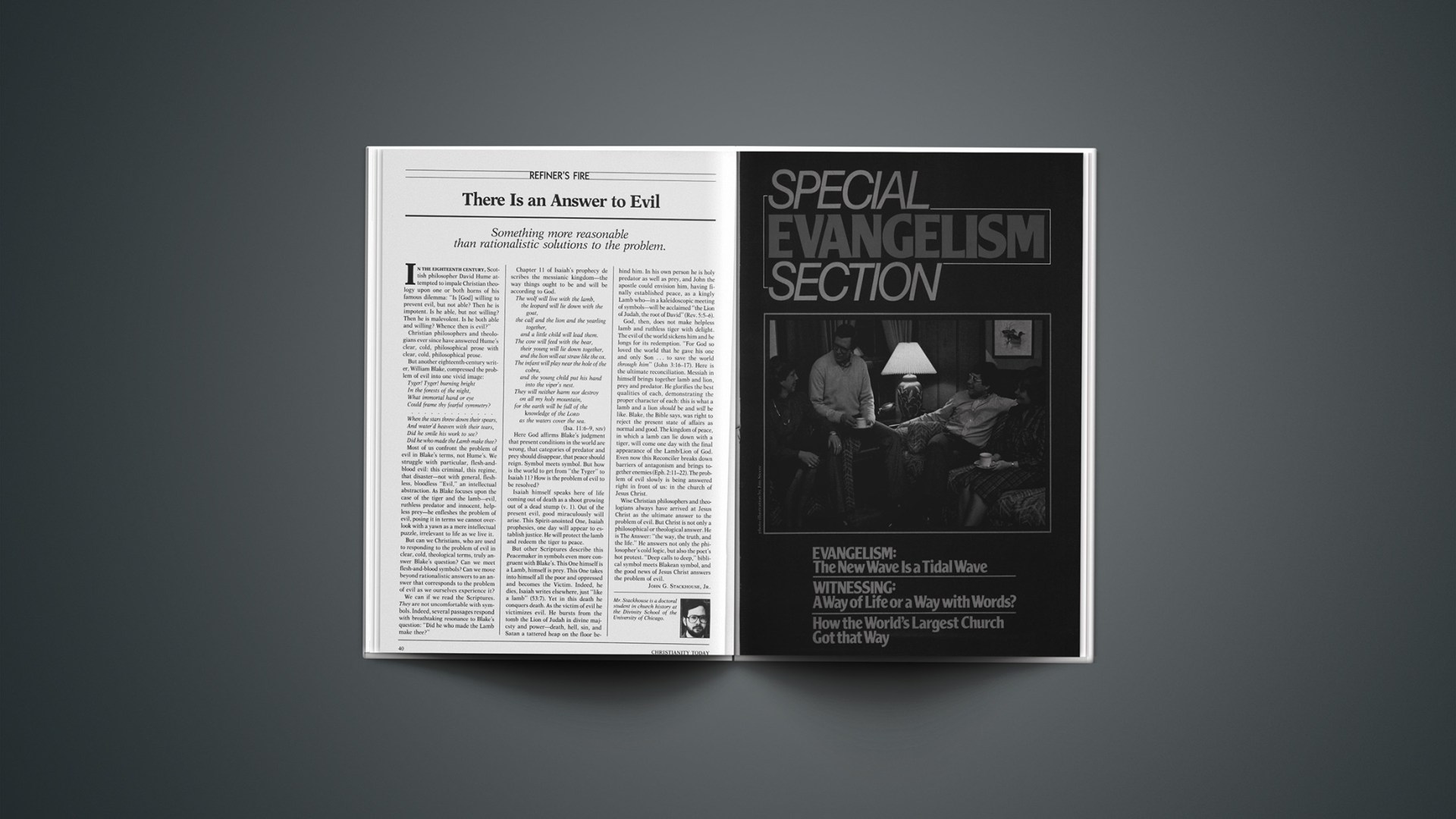Something more reasonable than rationalistic solutions to the problem.
In the eighteenth century, Scottish philosopher David Hume attempted to impale Christian theology upon one or both horns of his famous dilemma: “Is [God] willing to prevent evil, but not able? Then he is impotent. Is he able, but not willing? Then he is malevolent. Is he both able and willing? Whence then is evil?”
Christian philosophers and theologians ever since have answered Hume’s clear, cold, philosophical prose with clear, cold, philosophical prose.
But another eighteenth-century writer, William Blake, compressed the problem of evil into one vivid image:
Tyger! Tyger! burning bright
In the forests of the night,
What immortal hand or eye
Could frame thy fearful symmetry?
When the stars threw down their spears,
And water’d heaven with their tears,
Did he smile his work to see?
Did he who made the Lamb make thee?
Most of us confront the problem of evil in Blake’s terms, not Hume’s. We struggle with particular, flesh-and-blood evil: this criminal, this regime, that disaster—not with general, fleshless, bloodless “Evil,” an intellectual abstraction. As Blake focuses upon the case of the tiger and the lamb—evil, ruthless predator and innocent, helpless prey—he enfleshes the problem of evil, posing it in terms we cannot overlook with a yawn as a mere intellectual puzzle, irrelevant to life as we live it.
But can we Christians, who are used to responding to the problem of evil in clear, cold, theological terms, truly answer Blake’s question? Can we meet flesh-and-blood symbols? Can we move beyond rationalistic answers to an answer that corresponds to the problem of evil as we ourselves experience it?
We can if we read the Scriptures. They are not uncomfortable with symbols. Indeed, several passages respond with breathtaking resonance to Blake’s question: “Did he who made the Lamb make thee?”
Chapter 11 of Isaiah’s prophecy de scribes the messianic kingdom—the way things ought to be and will be according to God.
The wolf will live with the lamb,
the leopard will lie down with the goat,
the calf and the lion and the yearling together,
and a little child will lead them.
The cow will feed with the bear,
their young will lie down together,
and the lion will eat straw like the ox.
The infant will play near the hole of the cobra,
and the young child put his hand into the viper’s nest.
They will neither harm nor destroy
on all my holy mountain,
for the earth will be full of the knowledge of the LORD
as the waters cover the sea.
(Isa. 11:6–9, NIV)
Here God affirms Blake’s judgment that present conditions in the world are wrong, that categories of predator and prey should disappear, that peace should reign. Symbol meets symbol. But how is the world to get from “the Tyger” to Isaiah 11? How is the problem of evil to be resolved?
Isaiah himself speaks here of life coming out of death as a shoot growing out of a dead stump (v. 1). Out of the present evil, good miraculously will arise. This Spirit-anointed One, Isaiah prophesies, one day will appear to establish justice. He will protect the lamb and redeem the tiger to peace.
But other Scriptures describe this Peacemaker in symbols even more congruent with Blake’s. This One himself is a Lamb, himself is prey. This One takes into himself all the poor and oppressed and becomes the Victim. Indeed, he dies, Isaiah writes elsewhere, just “like a lamb” (53:7). Yet in this death he conquers death. As the victim of evil he victimizes evil. He bursts from the tomb the Lion of Judah in divine majesty and power—death, hell, sin, and Satan a tattered heap on the floor behind him. In his own person he is holy predator as well as prey, and John the apostle could envision him, having finally established peace, as a kingly Lamb who—in a kaleidoscopic meeting of symbols—will be acclaimed “the Lion of Judah, the root of David” (Rev. 5:5–6).
God, then, does not make helpless lamb and ruthless tiger with delight. The evil of the world sickens him and he longs for its redemption. “For God so loved the world that he gave his one and only Son … to save the world through him” (John 3:16–17). Here is the ultimate reconciliation. Messiah in himself brings together lamb and lion, prey and predator. He glorifies the best qualities of each, demonstrating the proper character of each: this is what a lamb and a lion should be and will be like. Blake, the Bible says, was right to reject the present state of affairs as normal and good. The kingdom of peace, in which a lamb can lie down with a tiger, will come one day with the final appearance of the Lamb/Lion of God. Even now this Reconciler breaks down barriers of antagonism and brings together enemies (Eph. 2:11–22). The problem of evil slowly is being answered right in front of us: in the church of Jesus Christ.
Wise Christian philosophers and theologians always have arrived at Jesus Christ as the ultimate answer to the problem of evil. But Christ is not only a philosophical or theological answer. He is The Answer: “the way, the truth, and the life.” He answers not only the philosopher’s cold logic, but also the poet’s hot protest. “Deep calls to deep,” biblical symbol meets Blakean symbol, and the good news of Jesus Christ answers the problem of evil.
Mr. Stackhouse is a doctoral student in church history at the Divinity School of the University of Chicago.









